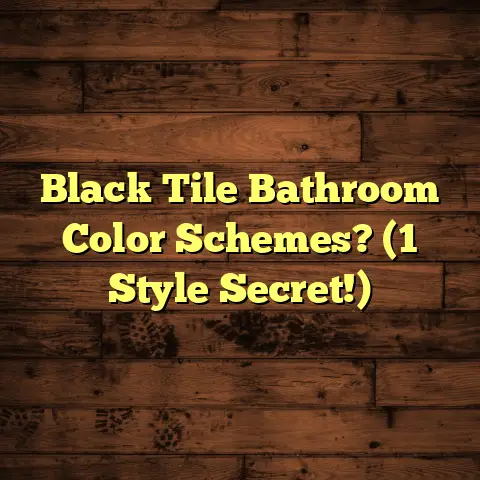Cost to Refinish Hardwood Floors in Romania
Refinishing hardwood floors is a popular home improvement project for many homeowners in Romania. It not only restores the beauty of the floors but can also significantly enhance the overall aesthetic appeal of a home. However, understanding the costs involved is crucial for making informed decisions.
This comprehensive guide will delve into various aspects of refinishing hardwood floors, including cost factors, detailed breakdowns, comparisons with alternative flooring options, and maintenance tips.
Overview of Cost Factors
When estimating the cost to refinish hardwood floors, several key factors come into play. Each of these factors can significantly influence the total cost of the project.
1. Area Size
The first and foremost factor affecting the cost of refinishing hardwood floors is the total square footage of the area to be worked on. Typically, contractors charge on a per-square-meter basis. Therefore, larger spaces will incur higher costs due to increased labor and material needs.
- Small Rooms: A small room, such as a bedroom or a home office, might average around 20 to 25 square meters. Refinishing costs in such spaces typically range from 400 RON to 750 RON depending on the condition of the floor and level of refinishing required.
- Medium Rooms: For medium-sized rooms, like living rooms or larger bedrooms (around 50 square meters), costs can range from 1,000 RON to 2,500 RON.
- Large Areas: In larger spaces, such as open-plan living areas or entire homes (100 square meters or more), costs can escalate to between 3,000 RON and 8,000 RON based on the complexity and condition of the flooring.
2. Type of Hardwood
The species of hardwood plays a significant role in determining the cost of refinishing. Different types of wood have varying densities and characteristics that affect how they are sanded and finished.
- Common Hardwoods: Oak and maple are among the most commonly used hardwoods for flooring in Romania. They tend to be more cost-effective to refinish due to their widespread availability.
- Exotic Hardwoods: Species like cherry, walnut, or teak may require specialized handling and products, resulting in higher costs for refinishing due to their rarity and unique properties.
3. Labor Costs
Labor costs vary widely across different regions in Romania. Urban areas tend to have higher labor costs compared to rural regions due to demand and living expenses. Additionally, a contractor’s experience can influence pricing:
- Experienced Contractors: Hiring skilled professionals may incur higher upfront costs but can lead to better results and longer-lasting finishes.
- Less Experienced Labor: Opting for less experienced workers might save money initially but could result in subpar work requiring additional refinishing in the near future.
4. Condition of the Floors
The initial condition of your hardwood floors is a critical aspect of determining the cost of refinishing. Floors that are well-maintained may require only light sanding and finishing, while those with significant wear or damage may need extensive work.
- Light Wear: Floors with minor scuff marks or dull finishes can often be refinished with minimal effort (basic sanding and re-coating), resulting in lower costs.
- Moderate Damage: If the floors have visible scratches or fading, more intensive sanding may be necessary, leading to moderate cost increases.
- Severe Damage: Extensive damage such as deep gouges, water damage, or structural issues will require repairs prior to refinishing, significantly increasing overall costs.
5. Additional Considerations
In addition to the aforementioned factors, there are other considerations that can impact costs:
- Floor Removal: If existing flooring needs to be removed before refinishing (for instance, if there is carpet over hardwood), this will add labor and disposal fees.
- Subfloor Replacement: If the subfloor is damaged or unstable, it may require replacement, adding further costs to your project.
- Material Grade: The quality of finishes, stains, and sealers chosen for the project can greatly influence the final cost. Higher-quality products provide better durability and appearance but come at a premium price point.
- Room Size/Layout: Unusual room shapes or layouts can complicate the refinishing process, potentially increasing labor hours and costs.
- Installation Type: Full refinishing (sanding down to bare wood) will generally cost more than simple spot refinishing (just addressing specific damaged areas).
Detailed Cost Breakdown
Understanding specific cost ranges for different types of projects is essential for budgeting effectively. Here’s a breakdown based on various scenarios:
Average Cost Estimates
Basic Refinishing
Basic refinishing involves light sanding followed by applying a finish coat. Prices typically range from:
- 20 to 30 RON per square meter for spaces in good condition that require minimal work.
Moderate Refinishing
Moderate refinishing includes more extensive sanding and possibly some repairs:
- 30 to 50 RON per square meter for spaces showing noticeable wear but not severe damage.
Extensive Refinishing
Extensive refinishing is required for floors with significant damage needing repairs before refinishing:
- 50 to 80 RON per square meter for floors needing significant work or custom finishes.
Example Cost Scenarios
To illustrate the potential costs better, here are examples based on average room sizes:
- Small Room (20 m²):
- Basic Refinishing: 400 to 600 RON
- Moderate Refinishing: 600 to 1,000 RON
- Extensive Refinishing: 1,000 to 1,600 RON
- Medium Room (50 m²):
- Basic Refinishing: 1,000 to 1,500 RON
- Moderate Refinishing: 1,500 to 2,500 RON
- Extensive Refinishing: 2,500 to 4,000 RON
- Large Room (100 m²):
- Basic Refinishing: 2,000 to 3,000 RON
- Moderate Refinishing: 3,000 to 5,000 RON
- Extensive Refinishing: 5,000 to 8,000 RON
Additional Costs
It’s also essential to consider potential additional costs that could arise during the refinishing process:
- Repairs: If the floors require repairs before refinishing (e.g., replacing damaged boards), this could add anywhere from 500 RON to several thousand RON depending on the extent of the damage.
- Finishes & Stains: The type of finish or stain selected can also influence prices; higher-end finishes often range from 30 RON to over 100 RON per liter.
Comparison with Alternative Flooring Options
When contemplating refinishing hardwood floors, it is beneficial to compare costs with alternative flooring materials. Each option has its pros and cons regarding price, durability, aesthetics, and maintenance requirements.
1. Laminate Flooring
- Cost Range: Generally between 40 to 150 RON per square meter depending on quality.
Pros:
- Affordable.
- Easy installation; often available as click-lock systems.
- Resistant to scratches and moisture.
Cons:
- Cannot be refinished; once worn out, it must be replaced.
- Lacks the warmth and authenticity of hardwood.
2. Vinyl Flooring
- Cost Range: Approximately 30 to 120 RON per square meter.
Pros:
- Water-resistant; suitable for kitchens and bathrooms.
- Available in various designs and textures resembling wood.
Cons:
- Less durable than hardwood; may need replacement every few years.
- Can emit VOCs (volatile organic compounds) after installation.
3. Carpet
- Cost Range: Typically between 50 to 200 RON per square meter depending on fiber type.
Pros:
- Comfortable underfoot; good insulation.
- Available in numerous colors and styles.
Cons:
- Stains easily; requires regular cleaning.
- Shorter lifespan compared to hardwood; often needs replacing every 5–10 years.
Cost Comparison Summary
| Flooring Type | Average Cost (RON/m²) | Durability | Maintenance |
|---|---|---|---|
| Hardwood | 20 – 80 | High | Moderate |
| Laminate | 40 – 150 | Moderate | Low |
| Vinyl | 30 – 120 | Moderate | Low |
| Carpet | 50 – 200 | Low | High |
Signs That Hardwood Floors Need Replacement
While refinishing can restore many hardwood floors to their former glory, there are situations where replacement is more appropriate. Here are key indicators that your hardwood floors may need replacing rather than refinishing:
Signs of Damage
- Deep Gouges or Scratches: If your floors have significant gouges that penetrate deeper than the finish layer and cannot be sanded out effectively without compromising structural integrity.
- Water Damage: Persistent water damage can lead to mold growth and structural decay within the wood itself. If you notice warping or cupping due to water exposure, it’s time for replacement.
- Structural Issues: Loose boards or significant gaps between planks may indicate that your flooring has suffered from structural failure and may not be viable for refinishing.
- Severe Fading or Discoloration: Floors that have been extensively faded by sunlight or other environmental factors may be beyond saving through refinishing alone.
- Unpleasant Odors: Musty or moldy smells emanating from beneath the floorboards could indicate hidden damage or mold growth that necessitates replacement rather than refinishing.
Considerations for Deciding Between Refinish vs. Replace
When faced with significant signs of wear or damage on your hardwood floors, consider these questions:
- Is the structural integrity compromised?
- Are repairs feasible within my budget?
- How long do I plan to stay in this home?
- What is my budget for flooring solutions?
If major repairs are required alongside refinishing efforts that push costs close to new flooring installation, replacing may be the more prudent choice in terms of investment return and overall home value enhancement.
Pros and Cons of Hardwood Flooring
Understanding the benefits and drawbacks of hardwood flooring can help you make an informed decision about whether it is suitable for your home.
Pros
- Aesthetic Appeal: Hardwood floors offer timeless elegance and enhance interior design aesthetics.
- Longevity: With proper care and maintenance, hardwood floors can last for decades or even centuries.
- Increases Property Value: Homes with hardwood flooring typically sell faster and at higher prices than those without.
- Versatility: Hardwood complements various design styles—from traditional to contemporary—making it suitable for all types of homes.
- Refinishing Capability: Unlike carpets or laminates, hardwood can be sanded down and refinished multiple times throughout its life cycle.
Cons
- Higher Initial Cost: The upfront investment for hardwood flooring is generally higher than that for alternatives like laminate or vinyl.
- Susceptibility to Damage: Hardwood can be scratched by pets or furniture; water spills can cause severe damage if not addressed promptly.
- Requires Regular Maintenance: Regular cleaning and occasional refinishing are necessary to keep hardwood looking its best.
- Noise: Hardwood flooring can produce sound when walked upon—this might not be ideal for multi-story homes or apartments where noise is a consideration.
- Temperature Sensitivity: Wood can expand or contract in response to humidity changes; maintaining consistent indoor climate conditions is essential for longevity.
Cost Differences: Professional Installation vs. DIY
Professional Installation
Hiring professionals for your hardwood floor refinishing project typically provides several advantages:
- Expertise and Quality Workmanship: Professionals bring experience that may yield better results than DIY efforts.
- Access to Professional Equipment: Specialized tools like commercial-grade sanders deliver superior results compared to consumer-grade equipment.
- Time Efficiency: Professionals can complete jobs more quickly due to their experience and efficiency.
- Warranties/Guarantees: Many professional services offer warranties on their work, providing peace of mind regarding quality.
Cost Consideration: Professional installation typically adds an additional cost ranging from 20% to 50% more than DIY methods due primarily to labor charges.
DIY Installation
While opting for DIY refinishing may save money up front, it requires careful planning and consideration:
Skills Required:
- Knowledge of sanding techniques: Improper sanding can lead to uneven surfaces or excessive wear on specific areas.
- Finishing application: Properly applying finishes requires precision for achieving an even coat without streaks or bubbles.
- Basic repairs: Skills in minor wood repairs will be necessary if any boards need replacement prior to finishing efforts.
Tools Needed:
For effective DIY refinishing, you’ll need access to tools such as:
- Floor sander
- Edge sander
- Vacuum cleaner
- Finish applicator (brushes/rollers)
- Safety gear (masks/goggles)
While doing it yourself can lead to substantial savings—often reducing costs by up to half—it’s essential first to assess both your skill level and willingness to invest time into learning necessary techniques before proceeding with a DIY approach.
Questions to Ask Hardwood Flooring Contractors
Choosing the right contractor can dramatically affect both your experience and end results when refinishing hardwood floors. Here are essential questions you should ask:
- What is your experience with hardwood floor refinishing?
- Can you provide references or examples of previous work?
- What types of finishes do you recommend based on my floor type?
- How long will it take to complete the project?
- What does your estimate include? Are there any hidden costs?
- How do you handle unforeseen issues during the project?
- Is there a warranty on your workmanship?
By ensuring clarity on these points beforehand, you’ll set clear expectations with your contractor while also gauging their professionalism and reliability as a service provider.
Hardwood Floor Care and Maintenance Tips
To maximize the longevity and beauty of your hardwood floors post-refinishing:
- Regular Cleaning:
- Sweep or vacuum frequently to remove dirt and debris which could scratch surfaces if left unattended.
- Use soft-bristle brooms or vacuums specifically designed for hardwood cleaning purposes.
- Use Proper Cleaners:
- Avoid harsh chemicals that can damage finishes; opt for pH-balanced cleaners specifically designed for hardwood floors.
- For regular maintenance cleaning solutions can include a mix of vinegar diluted in water (one cup vinegar per gallon) used sparingly on damp cloths rather than soaking wood surfaces directly.
- Protect Against Scratches:
- Use felt pads under heavy furniture legs; consider area rugs in high traffic zones like entryways or living areas where scratching is likely.
- Avoid walking on floors with high heels as this can cause indentations over time.
- Control Humidity:
- Maintain indoor humidity levels between 30% and 50% using humidifiers/dehumidifiers as needed; this helps prevent warping or cracking during seasonal changes in temperature/humidity levels.
- Refinishing Schedule:
- Plan on refinishing your hardwood floors every five to ten years based on usage levels—high traffic areas may require more frequent attention while less utilized rooms may extend their life longer without needing immediate care.
- Immediate Spill Cleanup:
- Address spills immediately using dry cloths rather than soaking them directly into wood surfaces; this will help prevent moisture seeping through seams causing long-term damage over time if left unaddressed regularly!
Conclusion
Refinishing hardwood floors in Romania presents an excellent opportunity for homeowners seeking aesthetic improvement while enhancing property value over time! Understanding various cost factors—ranging from area size/type of wood/labor condition—enables effective budgeting decisions tailored precisely toward individual needs throughout each step required within this process!
By weighing pros & cons against alternative flooring options alongside signs indicating either repair/replacement necessity as well ensuring clear communication when hiring contractors—homeowners position themselves advantageously while embarking upon revitalizing their beloved spaces through detailed preparation!
Whether opting towards professional services versus self-installation approaches—a comprehensive understanding coupled with diligent maintenance practices ensures lasting beauty achieved through well-refined choices ultimately leads toward satisfying outcomes desired by all parties involved!





